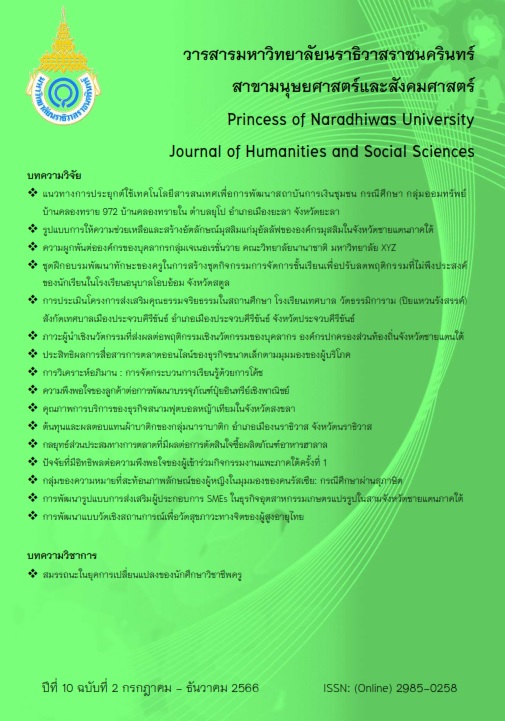กลุ่มของความหมายที่สะท้อนภาพลักษณ์ของผู้หญิงในมุมมองของคนรัสเซีย: กรณีศึกษาผ่านสุภาษิต
Main Article Content
บทคัดย่อ
บทความนี้มีวัตถุประสงค์ในการศึกษากลุ่มความหมายที่สะท้อนภาพลักษณ์ของผู้หญิงผ่านมุมมองของชาวรัสเซียในอดีต ผ่านการศึกษาสุภาษิตที่ปรากฏคำเรียกหรือสัญลักษณ์ที่สื่อถึงผู้หญิง โดยเน้นการวิเคราะห์ผ่านแหล่งข้อมูลรวบรวมสุภาษิตภาษารัสเซียจากพจนานุกรมสุภาษิต และแหล่งข้อมูลอิเล็กทรอนิกส์ จำนวน 65 สำนวน วิเคราะห์และจัดกลุ่มตามความหมายที่สะท้อนผ่านสุภาษิตเกี่ยวกับผู้หญิงในประเด็นต่าง ๆ เพื่อแสดงถึงภาพลักษณ์ทั้งในเชิงบวกและภาพลักษณ์เชิงลบของชาวรัสเซียที่มีต่อผู้หญิงในอดีต ผลการศึกษาพบว่า คนรัสเซียมีมุมมองเชิงลบต่อผู้หญิงมากกว่า เชิงบวกอย่างเห็นได้ชัด โดยภาพลักษณ์ที่ปรากฏในสุภาษิตสามารถแบ่งเป็นกลุ่มต่าง ๆ ได้แก่ 1) ภาพลักษณ์ของผู้หญิงด้านความไม่แน่นอนและการเปลี่ยนแปลงง่าย 2) ภาพลักษณ์ของผู้หญิงด้านภาระหน้าที่ 3) ภาพลักษณ์ของผู้หญิงด้านการพูดคุยนินทาและการส่งเสียงดัง 4) ภาพลักษณ์ของผู้หญิงด้านสติปัญญา 5) ภาพลักษณ์ของผู้หญิงด้านความขัดแย้งและความแตกแยก 6) ภาพลักษณ์ของผู้หญิงด้านการเน้นอารมณ์ความรู้สึกเป็นที่ตั้ง 7) ภาพลักษณ์ของผู้หญิงด้านข้อจำกัดของการใช้ประโยชน์และคุณค่า 8) ภาพลักษณ์ของผู้หญิงด้านพฤติกรรมที่ดื้อรั้น และ 9) ภาพลักษณ์ของผู้หญิงด้านการขาดความน่าเชื่อถือ การศึกษาดังกล่าวสามารถนำมาเป็นส่วนหนึ่งของกรณีศึกษาความสัมพันธ์ระหว่างภาษากับวัฒนธรรมทางความคิด ตลอดจนพัฒนาการทางประวัติศาสตร์ของบทบาทสตรีที่แฝงไปด้วยอคติบนสังคมของชายเป็นใหญ่ได้
Article Details

อนุญาตภายใต้เงื่อนไข Creative Commons Attribution-NonCommercial-NoDerivatives 4.0 International License.
เอกสารอ้างอิง
กัญญ์วรา เจนพินิจกุล และเกวลี เพชราทิพย์. (2566). ภาพลักษณ์ประเทศไทยผ่านรายการโทรทัศน์จีน : กรณีศึกษารายการวาไรตี้ ทอล์กโชว์ “ซื่อเจี้ยชิงเหนียนซัว”. วารสารมนุษยศาสตร์และสังคมศาสตร์ มหาวิทยาลัยมหาสารคาม, 42(1), 7-21.
กัลยาณี กฤตโตปการกิต. (2563). สำนวนจีน : ภาพสะท้อนโลกทัศน์ของชาวจีนต่อสตรีจีน. วารสารจีนศึกษา มหาวิทยาลัยเกษตรศาสตร์, 13(1), 271-301.
กุหลาบ มัลลิกะมาส. (2537). วรรณคดีวิจารณ์. กรุงเทพฯ: มหาวิทยาลัยรามคำแหง.
ทัศนัย โคตรทอง. (2560). ภาพลักษณ์ผู้สื่อข่าวที่ถูกสะท้อนบทบาทผ่านภาพยนตร์ไทย (การค้นคว้าอิสระนิเทศศาสตรมหาบัณฑิต). มหาวิทยาลัยกรุงเทพ, กรุงเทพฯ.
นูรีดา อิบนิสุลัยมาน. (2565). ภาพสตรีในสุภาษิตมลายู. วารสารอักษรศาสตร์, 51(1), 83-104.
พจนานุกรมฉบับราชบัณฑิตยสถาน. (2554). ภาพลักษณ์. สืบค้นจาก https://dictionary.orst.go.th
พรทิพย์ พิมลสินธ์. (2540). ภาพพจน์นั้นสำคัญยิ่ง: การประชาสัมพันธ์กับภาพพจน์. กรุงเทพฯ: ประกายพรึก.
วรารัชต์ มหามนตรี. (2557). ภาษิต สำนวน : ภาพสะท้อนโลกทัศน์ของคนไทยต่อผู้หญิง. วารสารอารยธรรมศึกษา โขง-สาละวิน, 5(2), 9-58.
วิลาสินีย์ แฝงยงค์. (2564). ภาพผู้หญิงที่สะท้อนผ่านสุภาษิตอิตาเลียน. วารสารอักษรศาสตร์, 50(1), 83-104.
เสรี วงษ์มณฑา. (2541). ภาพพจน์นั้น...สําาคัญไฉน. กรุงเทพฯ: ธีระฟิลม์และไซเท็กซ์.
สำนักงานราชบัณฑิตยสภา. (2550). สุภาษิต. สืบค้นจาก http://legacy.orst.go.th/?knowledges=สุภาษิต-๒๕-สิงหาคม-๒๕๕๐
อาทิตย์ จิตรโท. (2558). ภาพลักษณ์ในเชิงลบของผู้หญิงในสำนวนสุภาษิตสเปน. วารสารมนุษยศาสตร์สังคมศาสตร์ มหาวิทยาลัยขอนแก่น, 31(1), 131-146.
อุบล เทศทอง. (2548). โลกทัศน์ต่อชายหญิง : ภาพสะท้อนจากภาษิตเขมร. วารสารดำรงวิชาการคณะโบราณคดี มหาวิทยาลัยศิลปากร, 4(2), 131-155.
Bychkova, E. A. (2020). Gender stereotypes in proverbs and sayings of the Russian language.New Horizons of Russian Studies, 9, 9-14.
Dal, V. I. (1879). Proverbs of the Russian People. St. Petersburg: M. O. Wolf.
Dal, V. I. (1957). Proverbs of the Russian People. Collection. Moscow.
Dictionary of proverbs and sayings. (n.d.). Cities of ladies don't last long. Retrieved from https://slovarick.ru/19/
Dictionary of the Russian Language. (n.d.). Image. Retrieved from https://gufo.me/dict/ozhegov/ образ
Folk art. (2023). 12 popular expressions, the meaning of which is not known to everyone. Retrieved from https://folkrussia.ru/rabota/zabegalas-kak-najda-znachenie-pogovorki.html
Fomicheva, A.P. (2020). The role of proverbs and sayings in shaping the image of a women in the Russian language picture of the world. "Social and humanitarian problems of education and professional self-realization "Social Engineer-2020", 273-277.
Journal of Foma. (2023). Woman: made from the rib of a man?. Retrieved from https://foma.ru/ zhenshhina-sotvorennaya-iz-rebra-muzhchinyi.html
Kovyneva, M. (2023). Why do they say "a woman with a cart - it's easier for a mare?. Retrieved from https://www.culture.ru/s/vopros/baba-s-vozu-kobyle-legche/
Martynova, A. N. & Mitrofanova, V. V. (1986). Proverbs, sayings, riddles. Moscow.
Moiposlovicy. (n.d.). Proverbs About Women. Retrieved from https://moiposlovicy.ru/zhenschina.html
Our Tatarstan. (2020). Women's minds that Tatar sums. Retrieved from https://dzen.ru/media/nashtatarstan/jenskie-umy-chto-tatarskie-sumy5edb c95d784aeb7d7a944576
Radio Sputnik Fm. (2018). What is the difference between a bazaar and a market?. Retrieved from https://bash.news/sputnik/uroki-russkogo/78348-chem-otlichaetsja-bazar-ot-rynka-9989
Shaimardanova, M. R. & Akhmetova, L. A. (2021). Value Representation of Gender Stereotypes through Paroemias Containing Gender Nomination (Based on English and Russian Proverbs). Philology. Theory & Practice, 14(10), 3249-3254.
The world of idiomatic phrases. (2023). Interpretation and origin of the idiomatic phrase “there's no way to beat it into thick head”. Retrieved from https://www.fraze.ru/index.php/frazeol ogizm/na-bukvu-h/khot-kol-na-golove-teshi
The world of idiomatic phrases. (2023). The origin, meaning and use of the proverb "Baba (while) flies from the stove, seventy-seven thoughts will change her mind." Retrieved from https://fraze.ru/index. php/poslovitsy-pogovorki/poslov-na-bukvu-b/baba-poka-s-pechi-letit
Tokareva, N. A., Kirillova, T. S. & Konnova, O. V. (2019). Gender concepts of «woman, mother, girl» in Russian, English and Chinese phraseology. Bulletin of Kalmyk university scientific journal, 110-116.
Trusov, M. (2020). Seven Fridays a week: the meaning and origin of the expression. Retrieved from https://dzen.ru/media/id/5c1b6cb3d07efb00a93f3b7a/sem–piatnic–na–nedele-znach enIe–I–proIshojdenie-vyrajeniia5edf24d375cc01341718705a
Zhang, Q. (2020). The image of a man and woman on the example of Russian and Chinese Linguocultural systems (based on the analysis of phraseological units). The world of science, culture and education, 2(81), 466-468.


